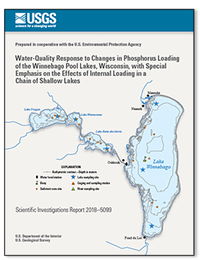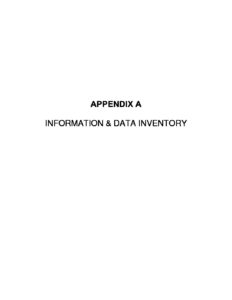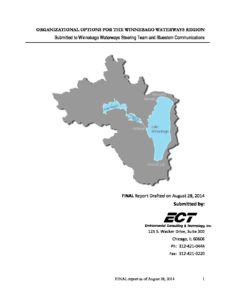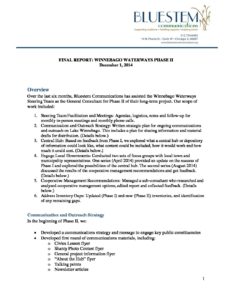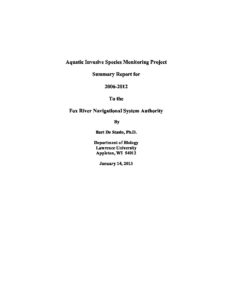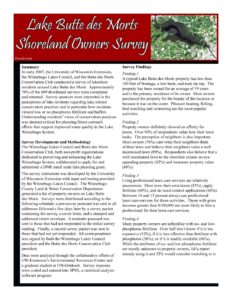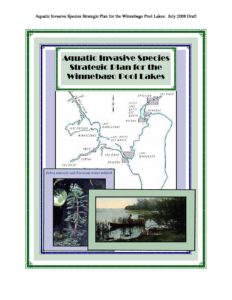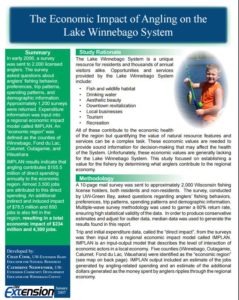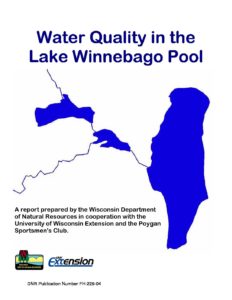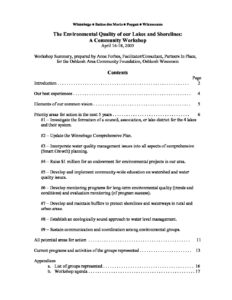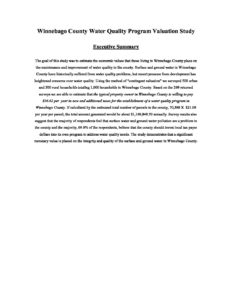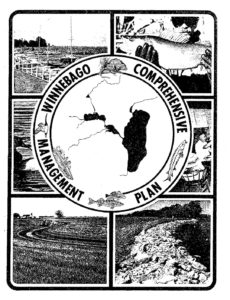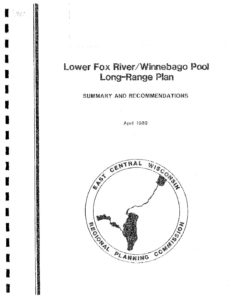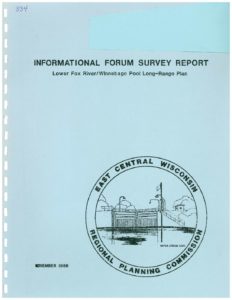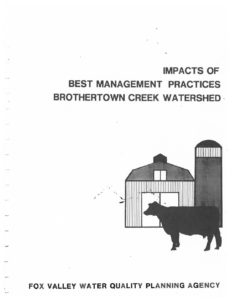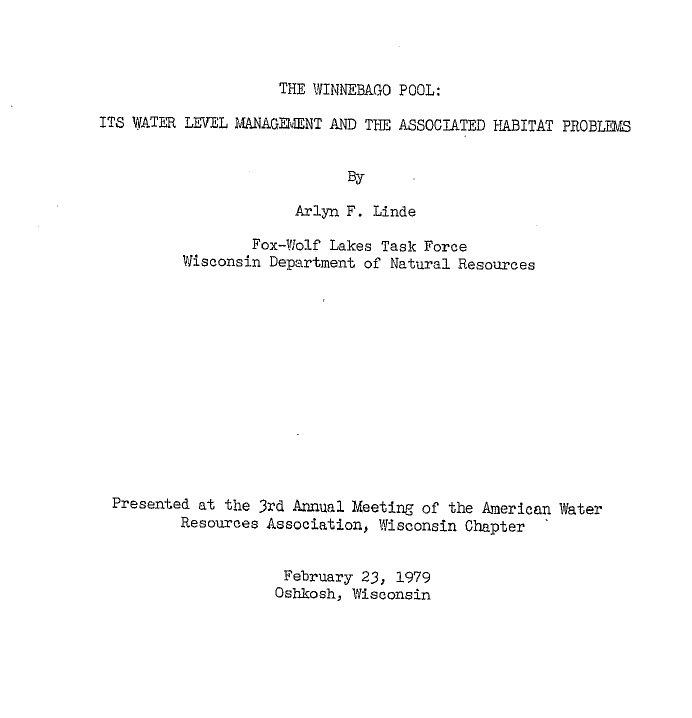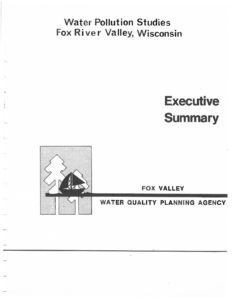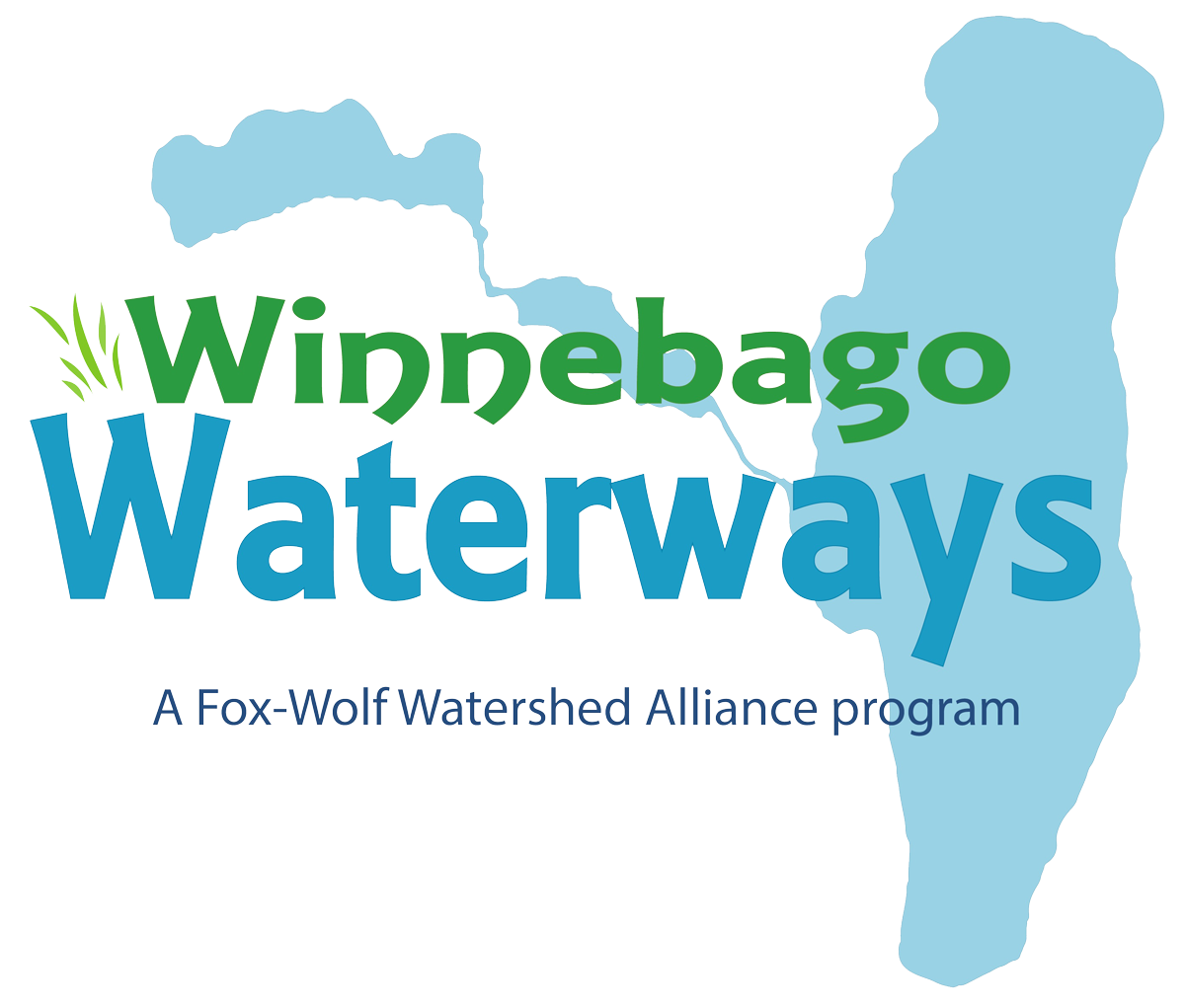Winnebago Waterways are vital our local economy and are important to the outdoor heritage of many people in the region. Here are just a few examples of the significance of the Winnebago System:
- Winnebago System contains 17% of Wisconsin’s surface water.
- More than 200,000 people get their drinking water from Lake Winnebago.
- $287 million per year is brought in to the regional economy because of recreational fishing.
- The System offers numerous recreational opportunities through public parks, boating, beaches, and more – all of which are important to area traditions and creating memories for generations to come.
There are many organizations and individuals who have or are currently doing incredible work to help protect and improve the waterways within the Winnebago System. This page is dedicated to archiving past work of the Winnebago Waterways Program and other organizations from around the system. This archive is incomplete – if you would like to see a project added to this page, please contact us.
For the most recent lake management plan in use today, CLICK HERE
Submit a Project
Email wwinfo@fwwa.org with the project information.
Past Efforts
USGS Studies and Publications (2018-2019)
Water-Quality Response to Changes in Phosphorus Loading of the Winnebago Pool Lakes, Wisconsin, with Special Emphasis on the Effects of Internal Loading in a Chain of Shallow Lakes, 2018
The study described in this report is part of a Total Maximum Daily Load investigation to determine what actions are needed to improve the water quality (trophic status) of these lakes and thus be able to be removed from the impaired waters list and restore their designated uses. As part of this study, data were collected to describe the existing water quality of the lakes, detailed phosphorus budgets were developed for each of the lakes to describe the different sources of the phosphorus, and two eutrophication models (BATHTUB and Jensen models) were used to determine how much of the phosphorus being input to the lakes needs to be reduced for the lakes to be removed from the impaired waters list and restore their designated uses.
<<CLICK HERE>> to access the full report
Winnebago pool lakes: Hydrology, water quality, and response to simulated changes in phosphorus loading, 2019
This study consists of only one year of data collection followed by data analysis and report preparation. Detailed water and phosphorus budgets will be developed for the Pool Lakes by measuring all major inflow and outflow sources and estimating the magnitude of minor sources. Current water quality (trophic state) of each of the four Winnebago Pool Lakes will be obtained from the Wisconsin DNR and evaluated relative to longer-term trends and to measured phosphorus loading through the use eutrophication models in BATHTUB and the Jensen shallow-lake model. The euthrophication models will then be used to simulate the likely response of each of the Pool Lakes to phosphorus loading changes associated with various lake-management actions that might be implemented and specific climate scenarios. Output from the Lake Winnebago to the Lower Fox River will be estimated from data collected by the Wisconsin DNR at Neenah and Menasha. Information from this study will be supplied to those modeling the watershed downstream of Lake Winnebago and to those developing TMDL’s for the system.
>>CLICK HERE<< to access the full report.
Winnebago Lakes Council (2005 – 2017)
 The Winnebago Lakes Council (2005-2017) was a non-profit organization focused on charitable, educational, and scientific endeavors for lakes Winnebago, Butte des Morts, Winneconne, Poygan and their connecting rivers. Their aim was to protect and improve the ecological health and scenic beauty of the lakes through citizen involvement. The organization was governed by a Board of Directors who were elected by dues-paying members. Membership was open to anyone who subscribed to their mission. Funding came from dues, donations, and grants. When the Council dissolved in 2017, they donated over $16,000 to the Winnebago Waterways Program at the Fox-Wolf Watershed Alliance. We are grateful for the generous contribution and plan to carry the WLC mission forward. This web page is a tribute to the WLC and the great work of its members.
The Winnebago Lakes Council (2005-2017) was a non-profit organization focused on charitable, educational, and scientific endeavors for lakes Winnebago, Butte des Morts, Winneconne, Poygan and their connecting rivers. Their aim was to protect and improve the ecological health and scenic beauty of the lakes through citizen involvement. The organization was governed by a Board of Directors who were elected by dues-paying members. Membership was open to anyone who subscribed to their mission. Funding came from dues, donations, and grants. When the Council dissolved in 2017, they donated over $16,000 to the Winnebago Waterways Program at the Fox-Wolf Watershed Alliance. We are grateful for the generous contribution and plan to carry the WLC mission forward. This web page is a tribute to the WLC and the great work of its members.
Weigh in on the Winnebago Waterways (2010 – 2015)
Between 2010 and 2012, an ad-hoc group of DNR and UW-Extension staff, residents, and a State Senator formed to discuss the management of a large, multi-jurisdictional lake system. Previous planning efforts acknowledged that management efforts were inconsistent and not coordinated. Many issues remained unresolved throughout the system with new issues having developed since the 1989 DNR plan was written. CEOs from Calumet, Fond du Lac, Outagamie, Waushara, and Winnebago Counties agreed to work together to address system-wide issues. This led to Phase I of the project – Weigh in on the Winnebago Waterways. (Dani Santry – Calumet County Presentation)
Phase I – Weigh in on the Winnebago Waterways (2013)
Phase I was partially funded by a Surface Water Planning grant from the Wisconsin Department of Natural Resources. The purpose of Phase I was to gain a better understanding of the social, environmental, and political factors that prevented comprehensive and collaborative management of the Winnebago System. Phase I also aimed to engage the public and other stakeholders to develop a list of issues of concern and ideas for improving water quality and management of the System.
Phase I results:
Phase I resulted in the development of a substantial inventory of data and information that had been collected on the Winnebago System. Public engagement activities: eight in-person public forums and an online forum; surveys (in-person, online, and mailed); press releases, Television, and radio ads; steering Team meetings (two per month). Total reach for Weigh in on the Winnebago efforts: 330 completed surveys; 341 people provided content online; 247 people attended meetings.
To download the Phase I Final Report, CLICK HERE
To download the Appendices, CLICK HERE
Video summary of Phase I
Phase II – Weigh in on the Winnebago Waterways (2014-2015)
Results from Phase I showed strong support to identify a way for all stakeholders to management the system cooperatively. Project partners initiated Phase II by applying for and obtaining a DNR Lake Planning Grant which was used to research various options for cooperative management. The overall goal of their effort was to ensure a cohesive approach is taken to managing the Winnebago waterways system in order to protect and enhance the health of the water resources, the regional economy and the quality of life in the region. Bluestem Communications and Environmental Consulting & Technology, Inc. (ECT) were retained to research cooperative management and provide a third party recommendation.
To read the findings, please CLICK HERE.
For the full Phase II report, please CLICK HERE.
Phase II results:
“Based on this analysis, ECT determined that a new or existing nonprofit provides the best opportunity to continue the efforts of the counties and other partners to achieve greater efficiencies and effectiveness in cooperating on key environmental and economic programs in the region.” (ECT Report, 2014).
This recommendation led three counties (Calumet, Fond du Lac, and Winnebago) to hire and partner with Fox-Wolf Watershed Alliance at the end of 2016 to facilitate the development of a Lake Management Plan for the four Winnebago Lakes.
To download the ECT report, CLICK HERE
To download the full Blue Stem report, CLICK HERE
Aquatic Invasive Species Monitoring Project Summary Report, 2013
Report summary: “As stated in the Aquatic Invasive Species (AIS) Control and Monitoring Plan of the Fox River Navigational System Authority (FRNSA, June 2006 version, Appendix B), the objective of the Rapide Croche AIS Monitoring Plan is to “monitor the presence and map the distribution of fish and invertebrate AIS in the Fox River two pools immediately up and downstream of Rapide Croche Lock.”
Monitoring studies have been conducted every summer between 2006 and 2012 at both upstream and downstream sites. The studies were completed under the supervision of Dr. Bart De Stasio, Ph.D., Department of Biology, Lawrence University, Appleton, WI. Between two and four students were employed during each summer to carry out the investigations. This report presents a summary of the monitoring data collected since 2006.
Developed by: Bart De Stasio, Ph.D. from Lawrence University for the Fox River Navigational System Authority (2013)
To download the full report, CLICK HERE
Current and Future Conservation Practices in the Winnebago Lake System: A Survey of Lake Butte des Morts Residents, January 2008
This survey of residential property owners assessed their lawn care habits, their perceptions of lake health and water quality, and their knowledge of, and willingness to adopt, appropriate conservation practices. The survey also paid particular attention to landowners’ views about alternatives to phosphorous fertilizer and installing buffers. An understanding of these points is critical to planning outreach programs to help improve water quality in the Lake Winnebago System.
The questionnaire was mailed to 609 residential property owners. 425 questionnaires were completed and returned for a response rate of 70%. The results of the survey indicated that, in general, people make their landscaping decisions with water quality and fish/wildlife habitat in mind, even though they sometimes fall short of best management practices. They were the survey’s key findings:
- Lawns: Lawn are important to people. Over 98% had lawn on their property. Most residents do their own lawn care. About half fertilize; about a third use herbicides. Over 70% think fertilizer adds pollution to the lakes. Not many know about low phosphorous fertilizer, but more than half would consider switching.
- Other Yard Practices: Most people keep sidewalks and driveways clear of clippings and leaves, use a mulching lawnmower and direct downspouts to the lawn. However, about 70% burn yard waste, with about half burning within 25 feet of the shoreline. Fewer than 10% have rain barrels, rain gardens or conduct soil test.
- Buffers: Only 36% have buffers. Three-fourths of buffers are less than 15 feet wide. Most people feel buffers help protect water quality and improve fish/wildlife habitat, but a large number also think they are messy, obstruct lake views and make access difficult. Half didn’t know where to find information about buffers.
Based on these findings the Lakes Council indicated they would be developing two educational programs: one to lessen use of phosphorous fertilizers and another to show the benefits of buffers.
To download a short version of the report, CLICK HERE
To download the full version of the report, CLICK HERE
Aquatic Invasive Species Strategic Plan for the Winnebago Pool Lakes: July 2008 Draft
The Lakes Council embarked on a major project to improve education, prevention, and planning for management and control of aquatic invasive species in the Winnebago Pool. In April 2006, a $75,000 Wisconsin Aquatic Invasive Species Control Grant was awarded by the WI DNR to the Winnebago County UW- Extension for work to be carried out by the Council and UW-Oshkosh. In 2009, a second grant was awarded to the Council to continue these efforts.
From these efforts, and with the assistance of several project participants, an AIS Strategic Plan was drafted in 2008*. This draft regional plan for AIS prevention and control was produced through a partnership between Winnebago County, UW Extension, UW Oshkosh, and the Winnebago Lakes Council.
To download the draft 2008 plan, CLICK HERE
*The 2008 plan was never formally finalized. Fox-Wolf Watershed Alliance is currently working with regional partners to draft an updated version of the AIS Strategic Plan for the Winnebago System as part of their Winnebago Waterways AIS Program. We hope to finalize the plan at the end of 2018.
Economic Impact of Angling on the Lake Winnebago System, UW-Extension 2007
Report summary: “In early 2006, a survey was sent to 2,000 licensed anglers. The survey asked questions about anglers’ fishing behavior, preferences, trip patterns, spending patters, and demographic information. Approximately 1,200 surveys were returned. Expenditure information was input into a regional economic impact model called IMPLAN. An “economic region” was defined as the counties of Winnebago, Fond du Lac, Calumet, Outagamie, and Waushara.
IMPLAN results indicate that angling contributes $155.5 million of direct spending annually to the economic region. Almost 3,500 jobs are attributed to this direct spending. An additional indirect and induced impact of $78.5 million and 800 jobs is also felt in the region, resulting in a total economic impact of $234 million and 4,300 jobs” (UW-Extension, 2007).
Developed by: Chad Cook and Catherine Neiwswender, UW-Extension
To download the full report, CLICK HERE
Water Quality in the Lake Winnebago Pool, DNR/UWEX/Poygan Sportsmen’s Club, 2004
The water quality of the Winnebago Pool lakes has been examined, or monitored to various degrees by the DNR for nearly 25 years. This report summarizes those actions and examines the data for trends, increasing or decreasing. Interactions of water quality to fish, wildlife, and aquatic plants are examined as well as the impact of exotic species on water quality.
Analysis of the collected data also answers the question of how close we are to reaching the goals identified in the Winnebago Comprehensive Management Plan (WCMP). The document also includes an action plan for further water quality monitoring.
Report was prepared by the Wisconsin Department of Natural Resources in cooperation with the University of Wisconsin Extension and the Poygan Sportsmen’s Club.
To view or download a copy of the 2004 report, CLICK HERE
The Environmental Quality of our Lake and Shorelines: A Community Workshop, Oshkosh Area Community Foundation, April 2003
The Oshkosh Area Community Foundation, with assistance from the Great Lakes Community Foundation Environmental Collaborative, a steering team of local leaders, and a professional facilitator, hosted a first-time gathering of representatives of 36 diverse organizations committed to charting a future for the environmental quality of the four Winnebago area lakes and their shorelines (within an approximate 2 mile zone around each lake).
The geographic focus of the workshop was the four Winnebago area shallow lakes (Winnebago, Buttes des Morts, Poygan, and Winneconne) and their immediate shorelands. While a number of initiatives address various aspects of the larger Wolf and Fox River watersheds, this workshop focused on the lakes and shorelands within Winnebago County.
Three themes of a common vision for 10 years into the future emerged. The themes were Environmental, Quality, Citizen Stewardship, and Innovative and Collaborative Management. For example, a couple of the identified common visions were: 1) Local governments all around the four lakes are leaders representing citizens’ goals for the lakes and shorelines and putting them into action; and 2) A new system-wide authority coordinates water resources management on the Winnebago Lakes (e.g. Lake District) and provides cohesion, visibility, and funding. The group then identified nine areas of action as being the most important to move effectively forward toward the vision. Workshop Summary was prepared by Anne Forbes, Facilitator/Consultant, Partners in Place, for the Oshkosh Area Community Foundation, Oshkosh, Wisconsin
To view or download a copy of the 2003 summary, CLICK HERE
Winnebago County Water Quality Program Valuation Study, 1997
The goal of this study was to estimate the economic values that those living in Winnebago County place on the maintenance and improvement of water quality in the county.
Surface and ground water in Winnebago County have historically suffered from water quality problems, but recent pressure from development has heightened concerns over water quality. Using the method of “contingent valuation” they surveyed 500 urban and 500 rural households totaling 1,000 households in Winnebago County. Based on the 269 returned surveys they were able to estimate that the typical property owner in Winnebago County is willing to pay $16.62 per year in new and additional taxes for the establishment of a water quality program in Winnebago County.
If calculated by the estimated total number of parcels in the county, 70,388 X $21.08 per year per parcel, the total amount generated would be about $1,169,848.50 annually. Survey results also suggest that the majority of respondents feel that surface water and ground water pollution are a problem in the county and the majority, 69.8% of the respondents, believe that the county should invest local tax payer dollars into its own program to address water quality needs. The study demonstrated that a significant monetary value is placed on the integrity and quality of the surface and ground water in Winnebago County.
The study was prepared by: Winnebago County Land Conservation Committee and UW-Extension
To view or download a copy of the study, CLICK HERE
To learn more about current Lake Management Planning efforts, CLICK HERE
1989 Winnebago Comprehensive Management Plan, WDNR
In 1989, a management plan for the Winnebago System was developed by the Wisconsin Department of Natural Resources in collaboration with several other resource stakeholders. The goal of the plan was, “to restore, improve, and maintain ecological diversity and quality, and beneficial uses of the fish, wildlife, and water resources of the Winnebago System”. Although many of the recommendations outlined by the comprehensive plan having been fulfilled, much has changed since the plan was written. The System faces new challenges which is why several partners are currently working to develop a new Winnebago Waterways Lake Management Plan (LMP). The LMP will provide a framework for strategic, coordinated management efforts as well as open up new funding opportunities to improve the health of the lakes.
To view or download a copy of the 1989 plan, CLICK HERE
To learn more about current Lake Management Planning efforts, CLICK HERE
Lower Fox River/Winnebago Pool Long-Range Plan, East Central Wisconsin Regional Planning Commission, April 1989
This plan provides a strategy for establishing the Lower Fox River as a corridor of national significance. It proposes to protect, enhance and promote the resources of the corridor to capitalize upon its ability to provide a unique experience of Midwestern heritage. At the heart of the strategy is the basic premise that the Lower Fox River is the single most important feature which connects the corridor’s communities and gives them a sense of cultural commonality. This plan is very similar to the Fox River Heritage State Parkway Concept Plan document. It appears to be a precursor to that document’s development.
To maximize the opportunities the river offers, the plan lists two major actions that must occur:
1) Water levels must continue to be managed in an objective fashion balancing the conflicting needs of diverse users. This ensures the commitment needed by all users that their investments in the system will be protected.
2) Through navigation from Green Bay to Oshkosh must be maintained. This is the continuous link throughout the corridor and the element essential to its historic authenticity.
Within this framework, the plan proposes policies and actions to realize historic recreational and commercial opportunities in the corridor without jeopardizing its environmental quality.
Two basic policies underlay all recommendations: 1) Economic development and environmental protection should be viewed interdependently; 2) Commercial and recreational development should be compatible with historic environs.
Major recommendations are:
· Continue operation of the lock and dam system
· Preserve and promote the historic significance of the corridor
· Enhance and expand recreational opportunities along the water
· Expand income and employment opportunities through development and expansion of commercial/recreational resources
To view or download a copy of the 1989 plan, CLICK HERE
To learn more about current Lake Management Planning efforts, CLICK HERE
Informational Forum Survey Report – Lower Fox River/Winnebago Pool Long-Range Plan, 1988
This document reports the findings of a survey conducted among attendees at an informational forum on the US Army Corps of Engineers Section 216 Disposition report for the Fox River Project. The purpose of the survey questionnaire was to present an opportunity for citizen response to the basic premise of the Corps of Engineers that the Fox River Project was authorized for commercial navigation alone and that the State of WI should assume responsibility for the project since commercial navigation is no longer conducted within the project.
One thousand people attended the meeting. 215 surveys were completed. Results indicated that most of the attendees (66.5%) had boating as an area of interest. The report assumes the large amount of boaters at the meeting was because of the placement of the Lower Fox River locks in caretaker (non-operational) status by the Corps at the end of the 1984 boating season.
Fishing and hunting on Lake Winnebago and the pool lakes had the second largest area of interest (13%). Flood control and water supply were identified as the most dependent users on the Corps’ management of Winnebago Pool levels and Lower Fox River flows.
98.6% of those who completed the survey felt that the Corps of Engineers should continue its responsibility for all or parts of the Fox River Project. The survey then asked if the federal government succeeds in disposing of the Fox River Project who then should handle its management. A new regional authority was the most preferred option.
To view or download a copy of the 1988 report, CLICK HERE
To learn more about current Lake Management Planning efforts, CLICK HERE
Impacts of Best Management Practices Brothertown Creek Watershed, August 1982
During the period May 1981 to October 1981 an extensive monitoring program was undertaken to determine the impact of best management practice (BMP) implementation within the agricultural Brothertown Creek Watershed. This small watershed (4.7 square miles) is located in southwest Calumet County just north of the Fond du Lac County line. Management practices had been installed through Wisconsin Fund and Agricultural Conservation Program cost-sharing.
Monitoring was conducted on a periodic basis throughout the six month period and several rain events were monitored during the six months as well. Samples were taken from eight sites from the source to the mouth and were analyzed for concentrations of seven parameters: suspended solids, total phosphorus, ortho-phosphate, nitrate plus nitrite, ammonia, Kjeldahl nitrogen, and chemical oxygen demand. Flow was measured whenever possible and a continuous record of flow was obtained at one station. Using concentration and flow data, pollutant loads were calculated at each sample site and annual loads were estimated for each parameter.
The impacts of BMPs along the stream were examined by comparing the loads present in the stream at each sample station. Several principal conclusions generated by the monitoring work are listed in the document.
To view or download a copy of the 1982 report, CLICK HERE
To learn more about current Lake Management Planning efforts, CLICK HERE
The Winnebago Pool: Its Water Level Management and The Associated Habitat Problems, 1979
In recent years continuing bog losses on the upriver lakes of Butte des Morts, Winneconne and Poygan have been noted with concern by riparian owners, game and fish managers and others. Sportsmen have become alarmed by loss of hunting and trapping areas and a continuing decline in waterfowl and fur bearer populations. These lakes, which were prime waterfowl hunting and pro duction areas through the first half of the 20th century and were considered the finest canvas back shooting areas in this section of the country, showed a drastic decline in waterfowl use during the past two decades.
In 1974, at the request of the Lake Michigan District of the DNR, a Fox Wolf Lakes Task Force was formed to investigate fish and game habitat problems besetting the upriver lakes of the Winnebago Pool (Lakes butte des Morts, Winneconne and Poygan). As a result of the preliminary findings of the Task Force, a continuing habitat study was set up.
A search was begun to compile a history of the area which would show conditions as they were, changes which occurred, and the possible reasons for change. It began with the pre-settlement era and proceeded to the present.
Not only written historical accounts, maps and photographs were checked, but trappers, fur farmers and local people were interviewed to get at the more recent changes. All available water level records for the lakes were studied in detail. A monitoring program was set up to record changes which are currently occurring in the habitat and studies were begun to determine methods for improving conditions. Findings of a portion of these studies are incorporated in this paper.
Water Pollution Studies, Fox River Valley, Executive Summary, May 1978
Prepared by: Fox Valley Water Quality Planning Agency
To view or download a copy of the 1978 report, CLICK HERE
During the Spring of 1976, the Fox Valley Water Quality Planning Agency (FVWQPA) entered into several contracts with public and private consultants to conduct studies to identify the existing and projected magnitudes of non-point source pollution in the Fox River Valley Watershed. These studies were necessary in order to complete portions of the FVWQPA’s Areawide Waste Treatment Management Planning responsibilities.
The study includes the following non-point source reports:
- Report #1-Test Watershed Monitoring and Sampling Program (estimation of pollutant loading from each sub-watershed in the 208 Study Area)
- Report #2-Sediment Source and Delivery Rate Study (estimate sediment source and delivery rates for the 45 sub-watersheds comprising the 208 Study Area)
- Report #3-Survey of Toxic Chemical Use and Distribution
- Report #4-Septic Tank Study
- Report #5-Instream Alteration (preliminary assessment of water quality impacts resulting from dredging activities)
In an attempt to quantify the fertility and biological productivity of the water bodies, two trophic status studies were sponsored by FVWQPA. Each study was conducted to explore, and if possible, develop models that would enable the FVWQPA to determine the importance of each pollution source (urban runoff, septic tanks, municipal treatment plants, etc.) to the trophic state of the Winnebago Pool and Lower Green Bay. The model determined that a 55% reduction in summer phosphorus concentration will be required to reduce algal mass to a point where there is good recreation potential, but at which nuisance conditions will occasionally occur. In order to achieve a high recreational potential with no nuisance blooms, a 76% reduction would be required.
The following in-lake management techniques were suggested to control phosphorus from a cost-effectiveness standpoint. To decrease turbidity, stabilize lake sediments, and remove a portion of the available phosphorus.
- Adjust spring or early summer water levels to generally lower the lake and prevent excessive peak flow levels that destroy or prevent re-establishment of aquatic vegetation.
- Begin artificial propagation of reed canes in the up river lakes of the Pool. This could be accomplished on natural or man-made underwater gravel ridges and would reduce wave energy and sediment re-suspension.
- Continue or increase fish management efforts such as rough fish removal. This would improve water clarity by reducing sediment disturbance and the “nutrient pumping” action of carp and sheep head species.
The study also includes the development of a nutrient budget, which provided a means of comparing the relative impact of controlling sources of phosphorus to reduce the water quality problems of the Winnebago Pool area which are caused by nutrient pollution.
Have a project to submit?
We’d love to hear about it!
Send an email to wwinfo@fwwa.org with the project details.
Winnebago Waterways is a Fox-Wolf Watershed Alliance recovery initiative.
Contact us at wwinfo@fwwa.org

